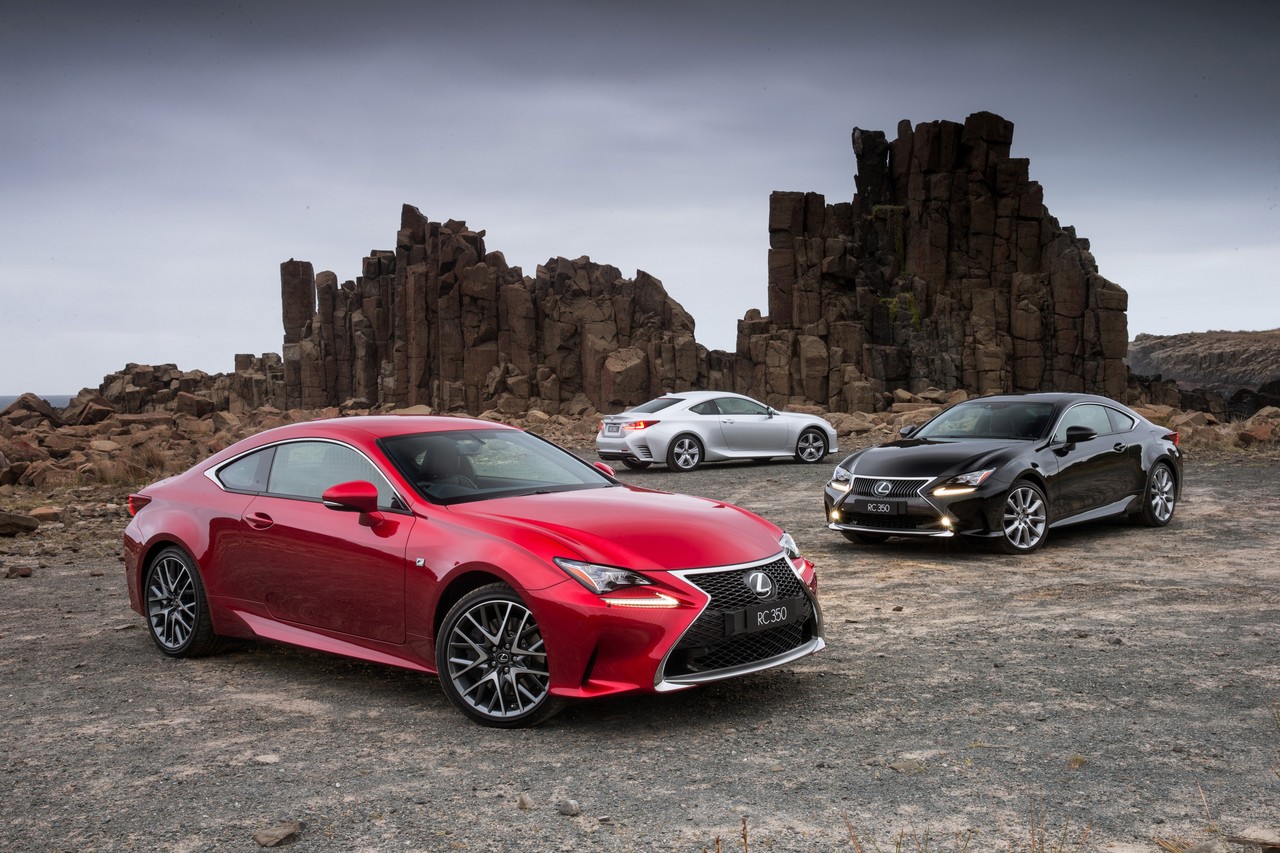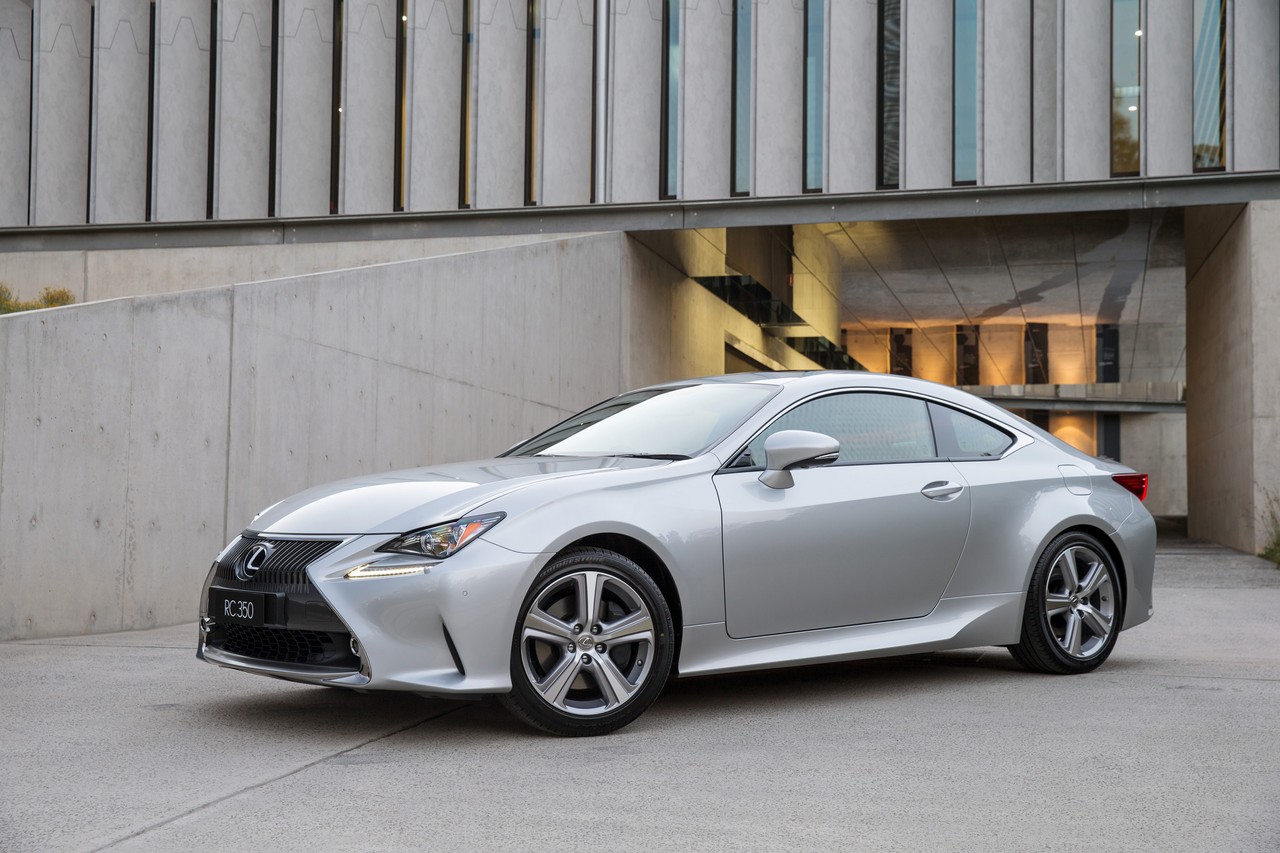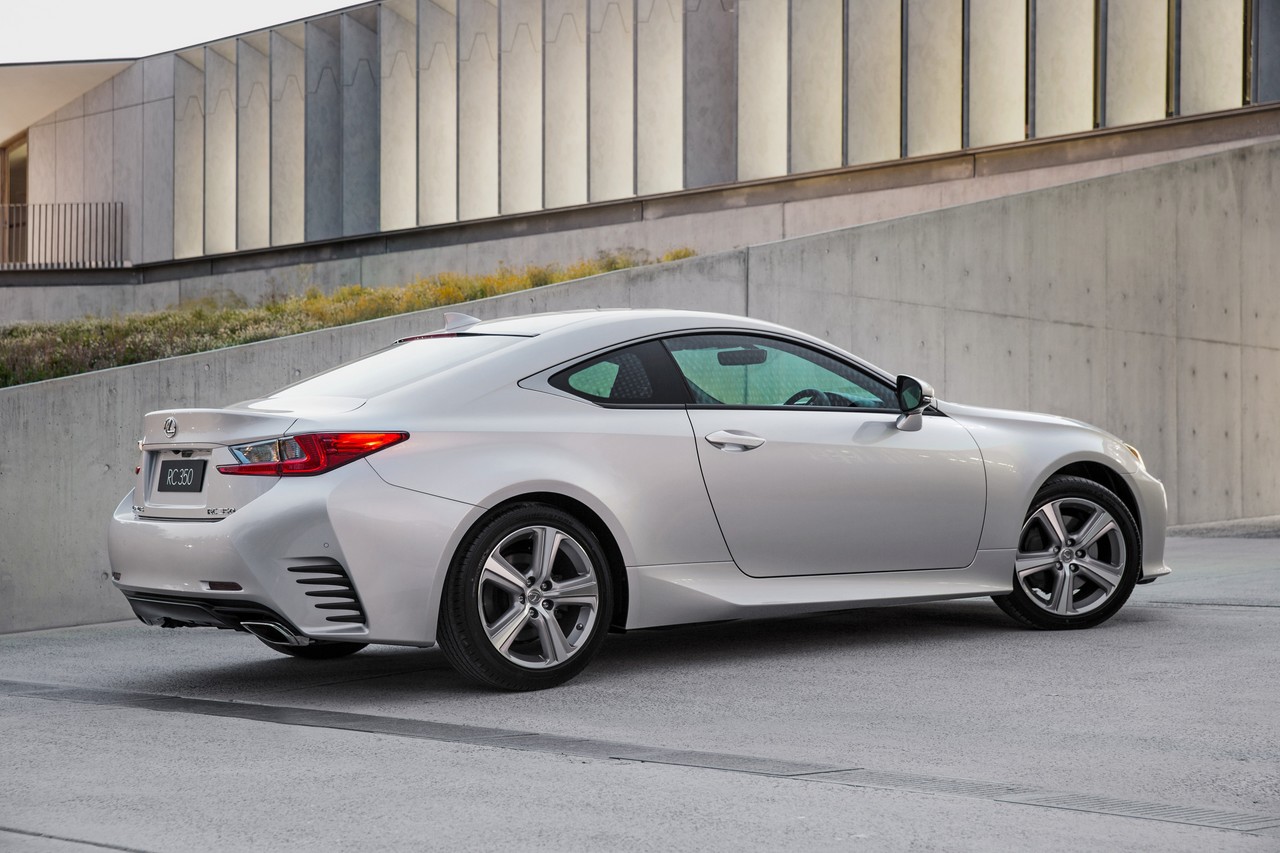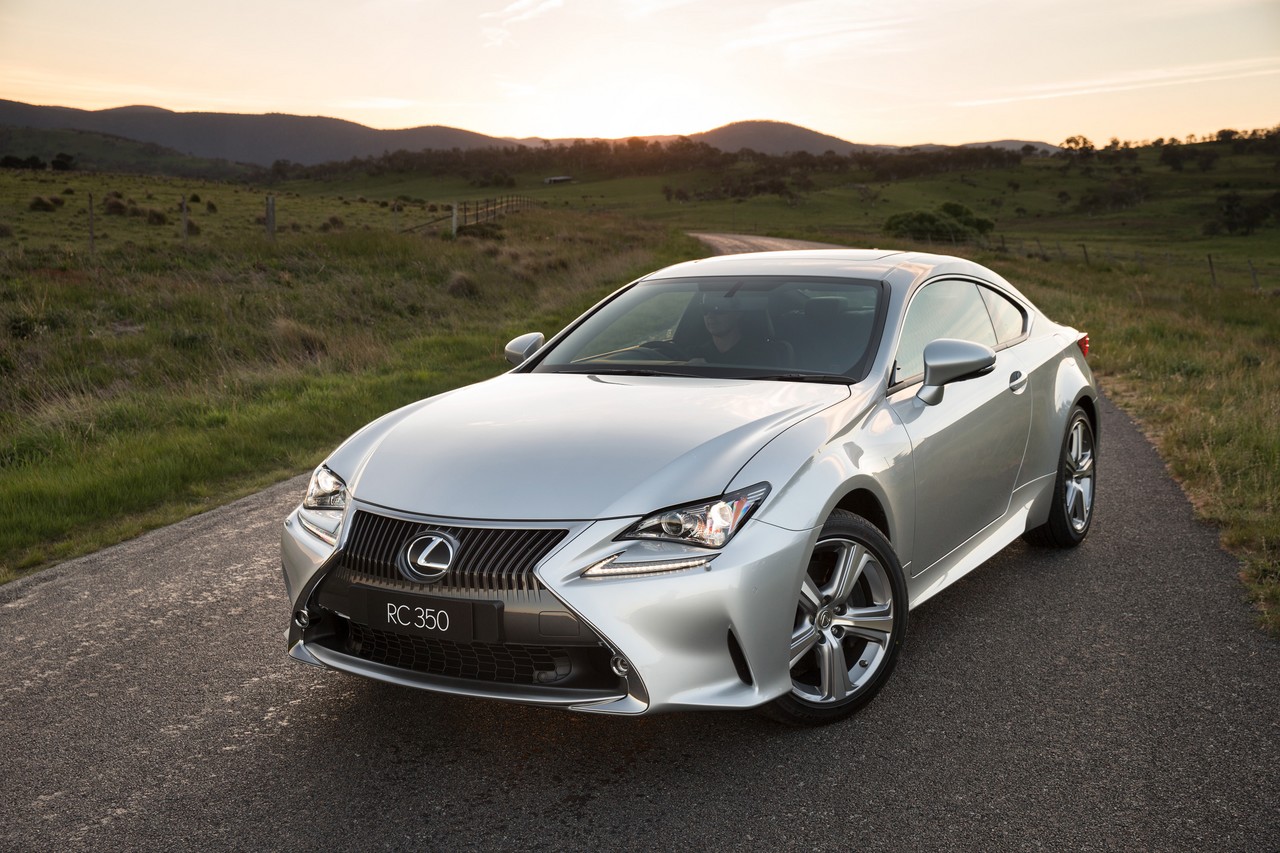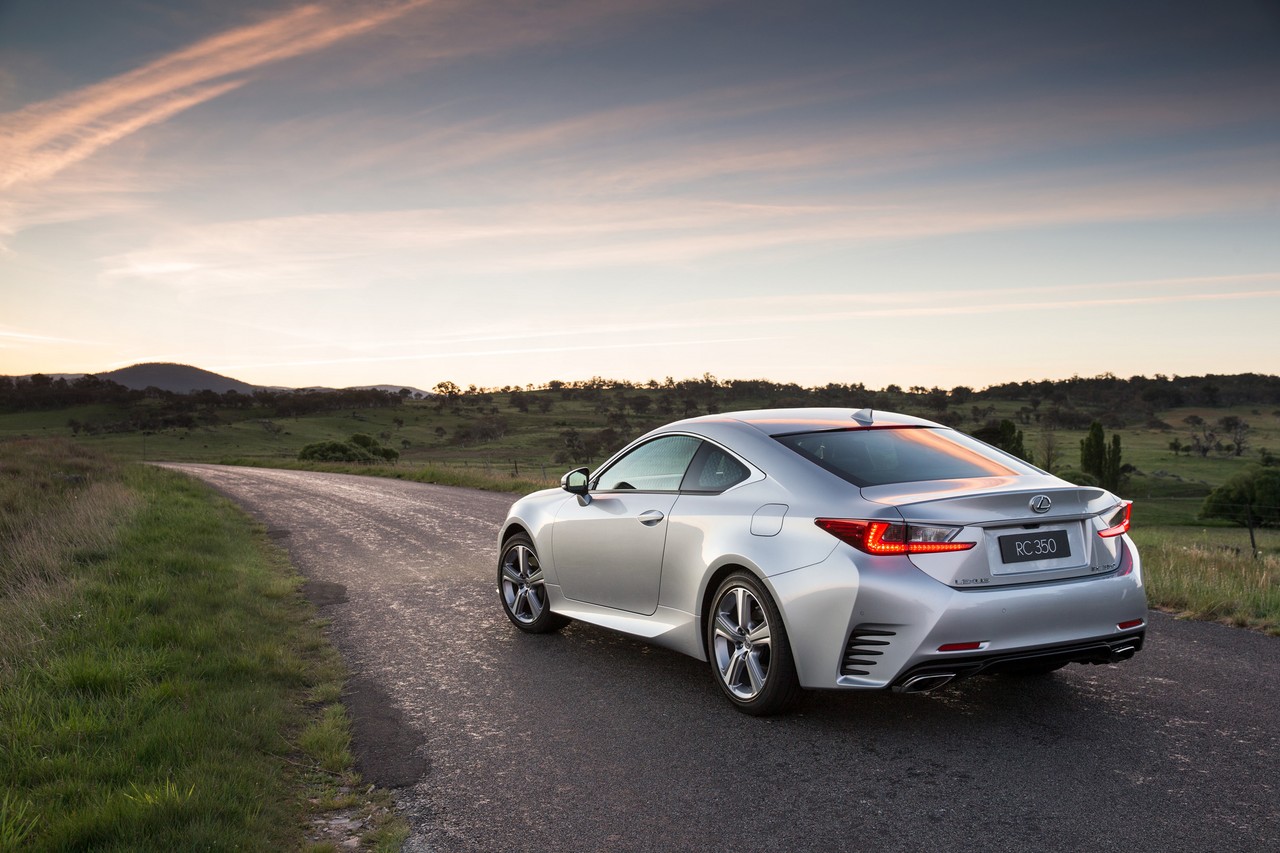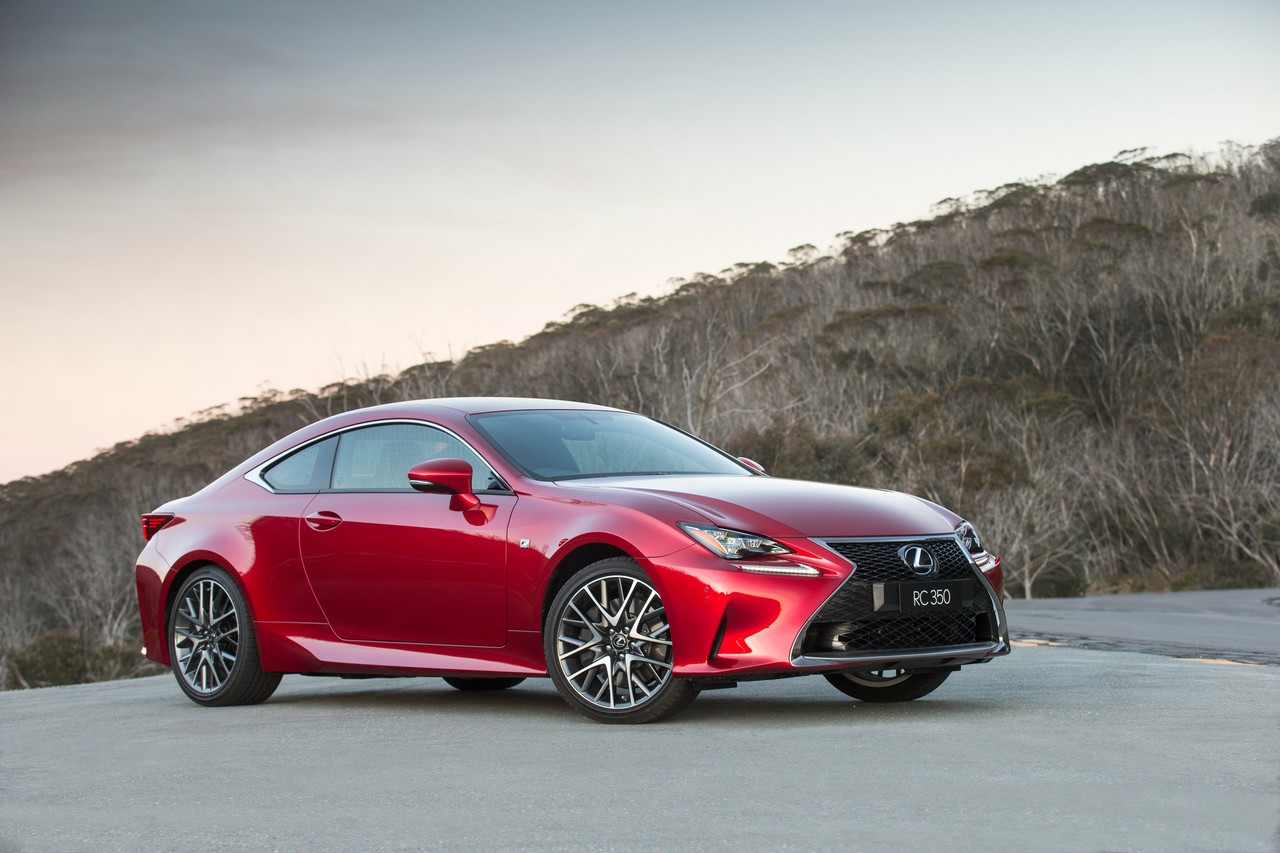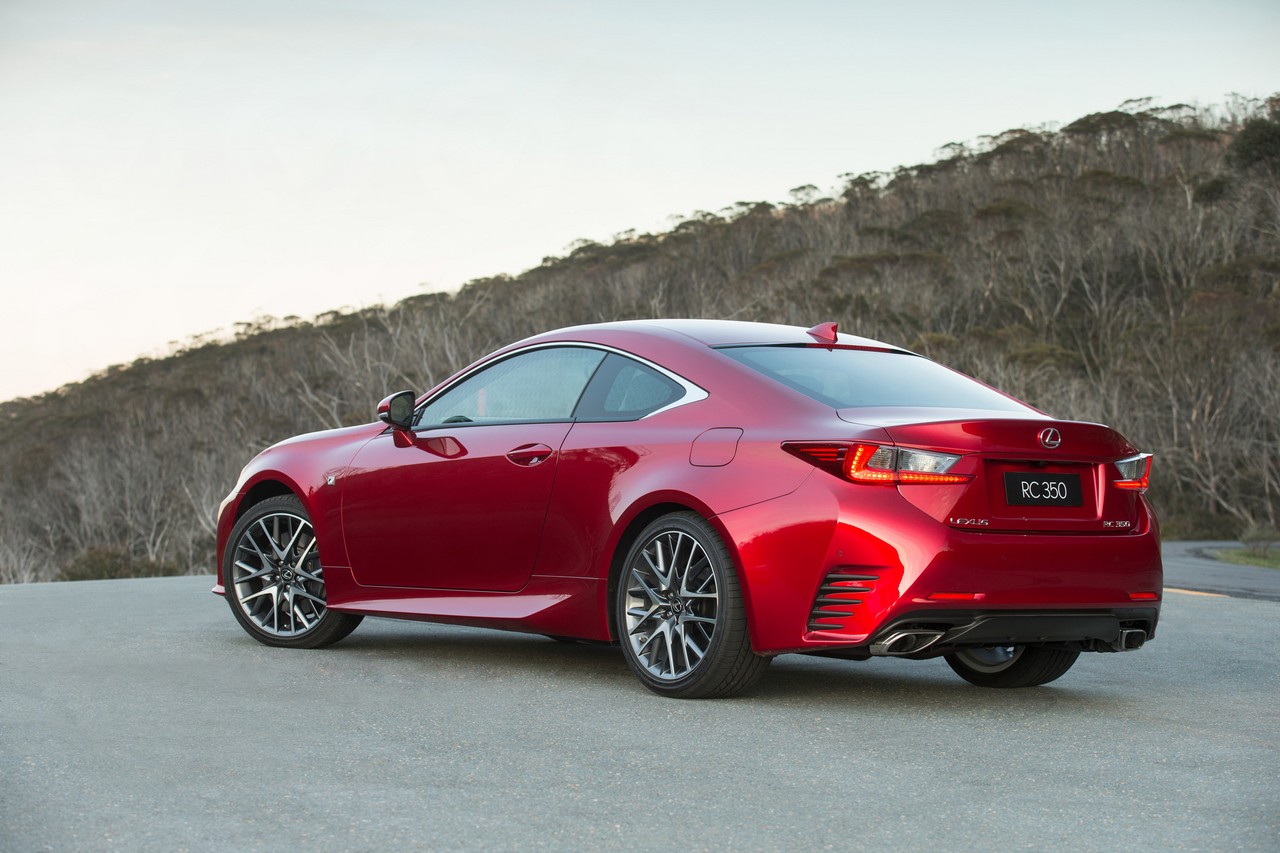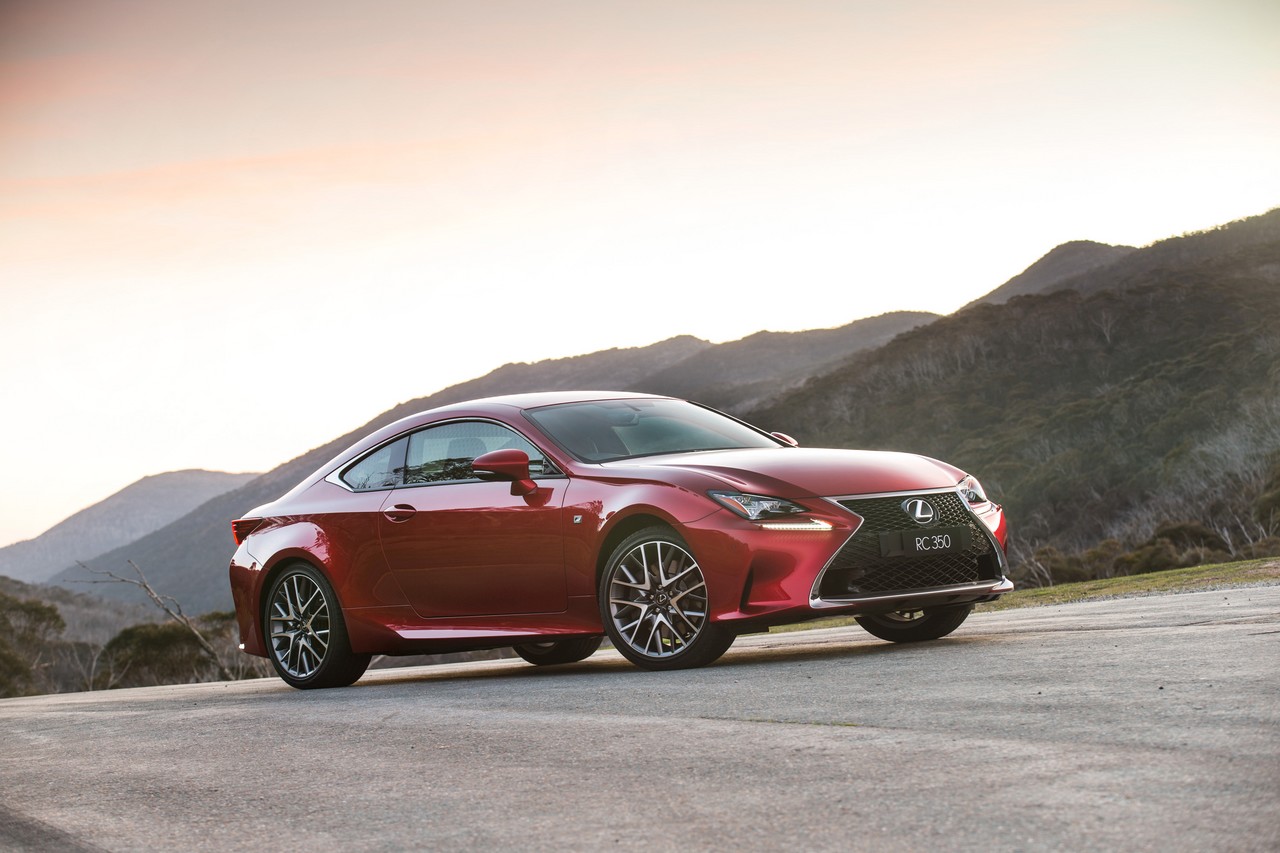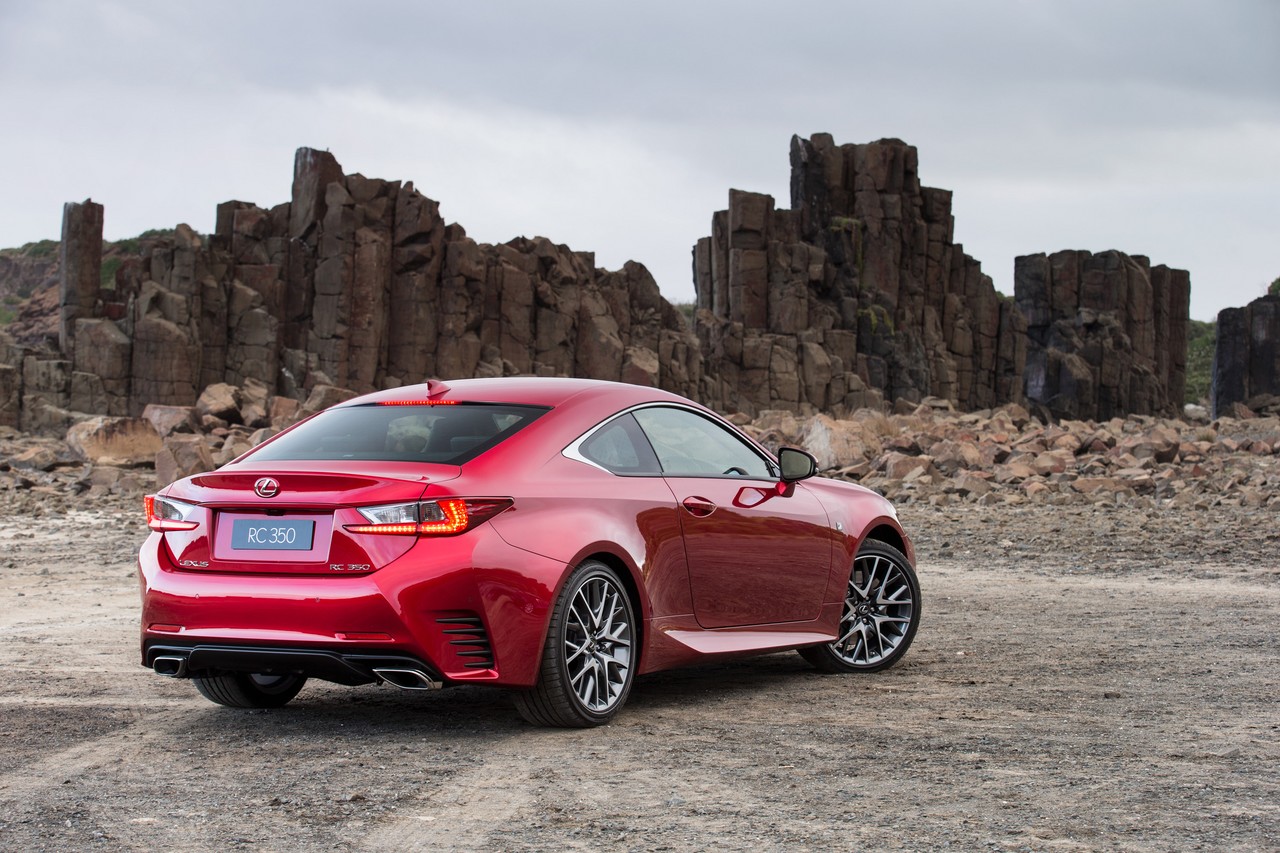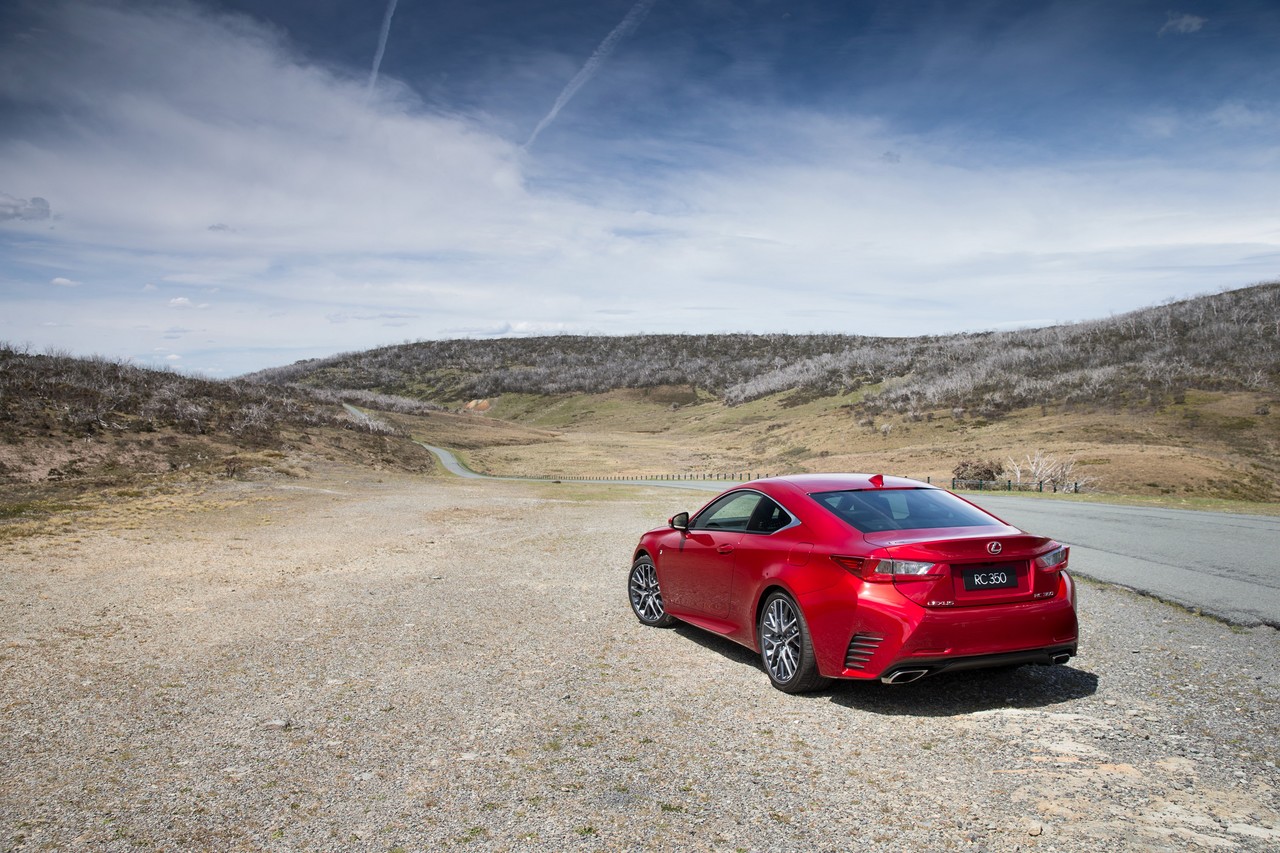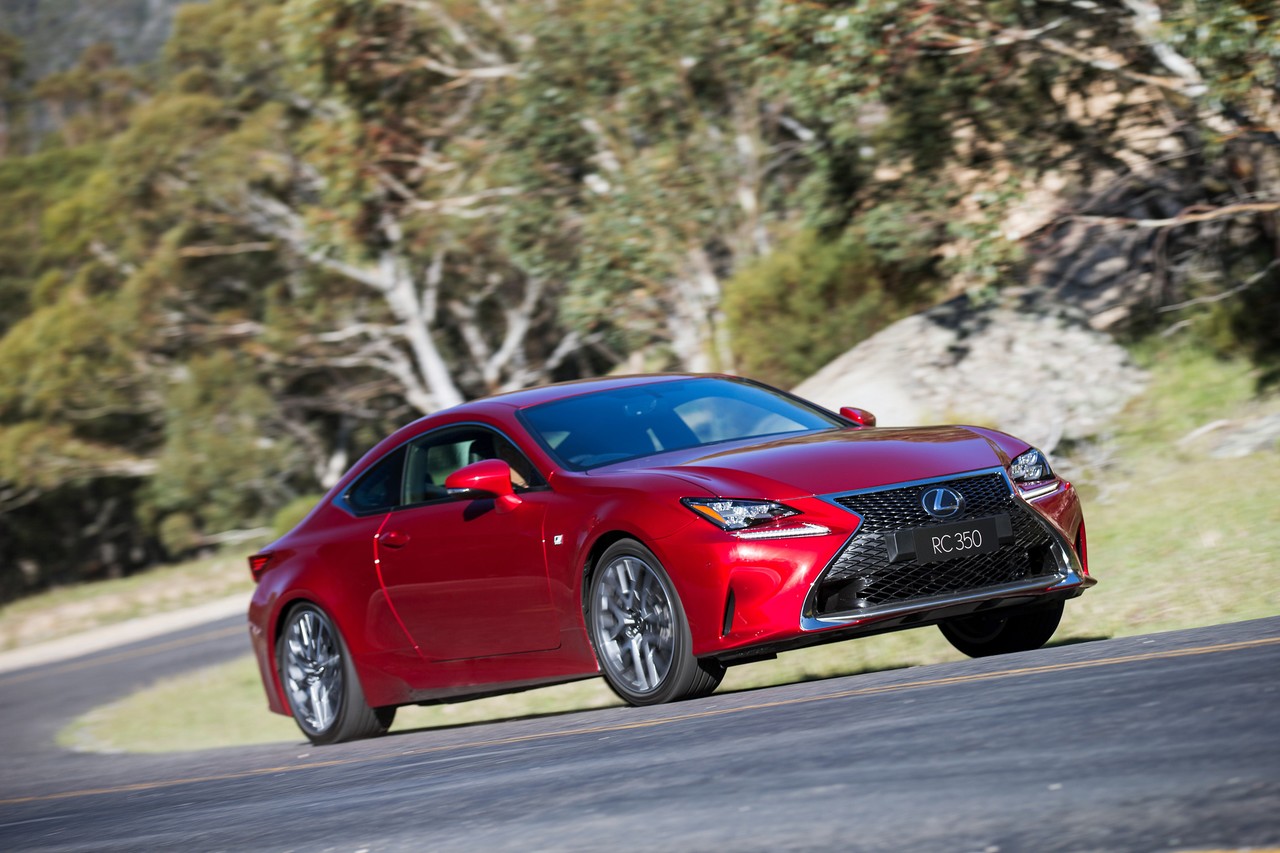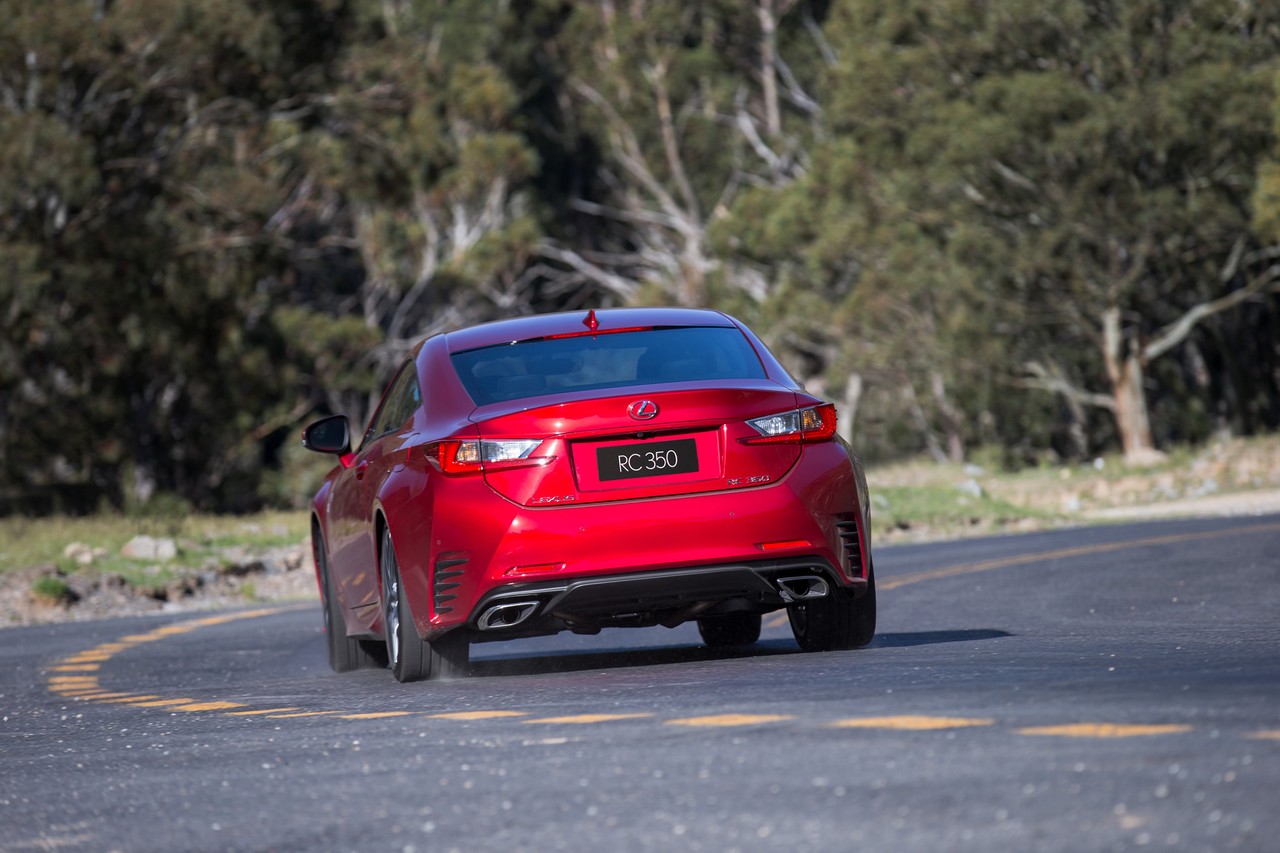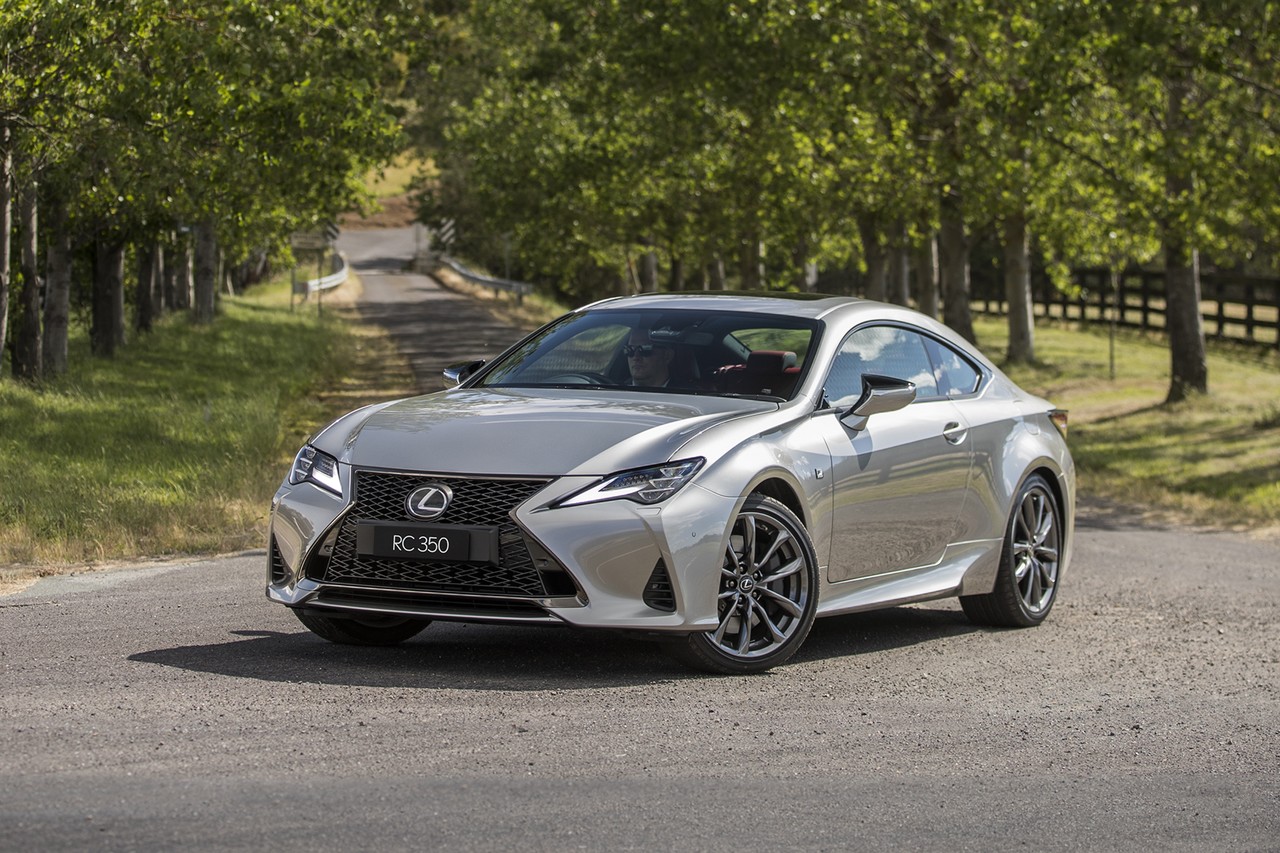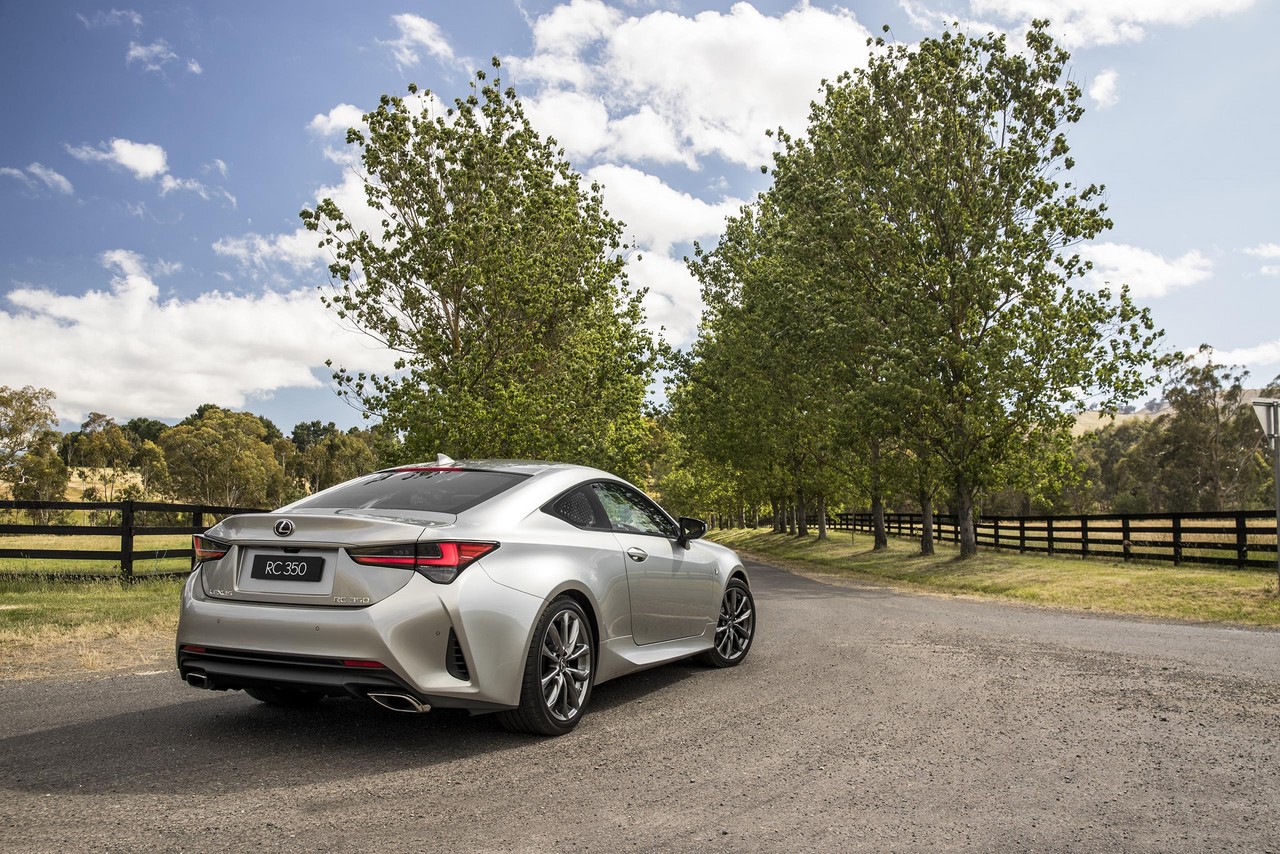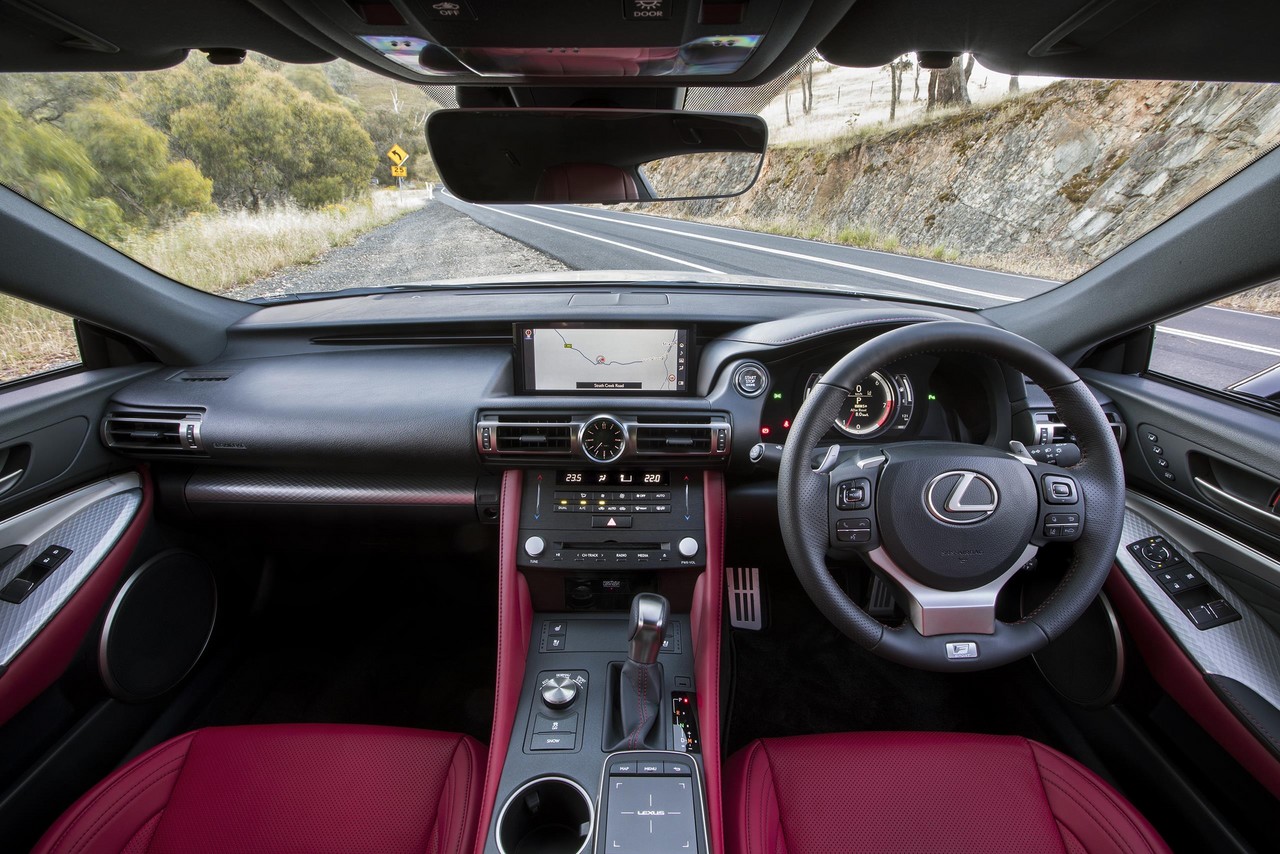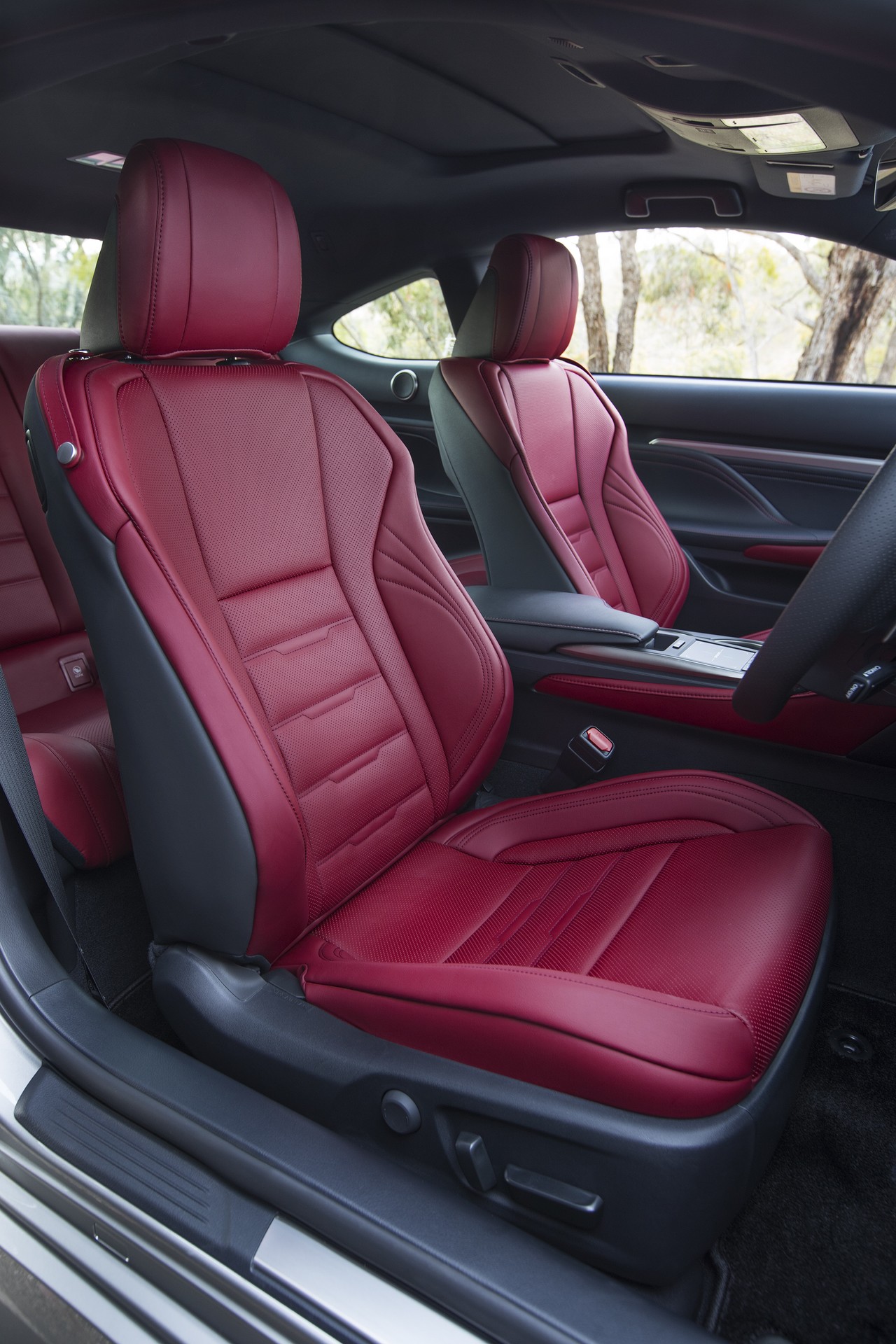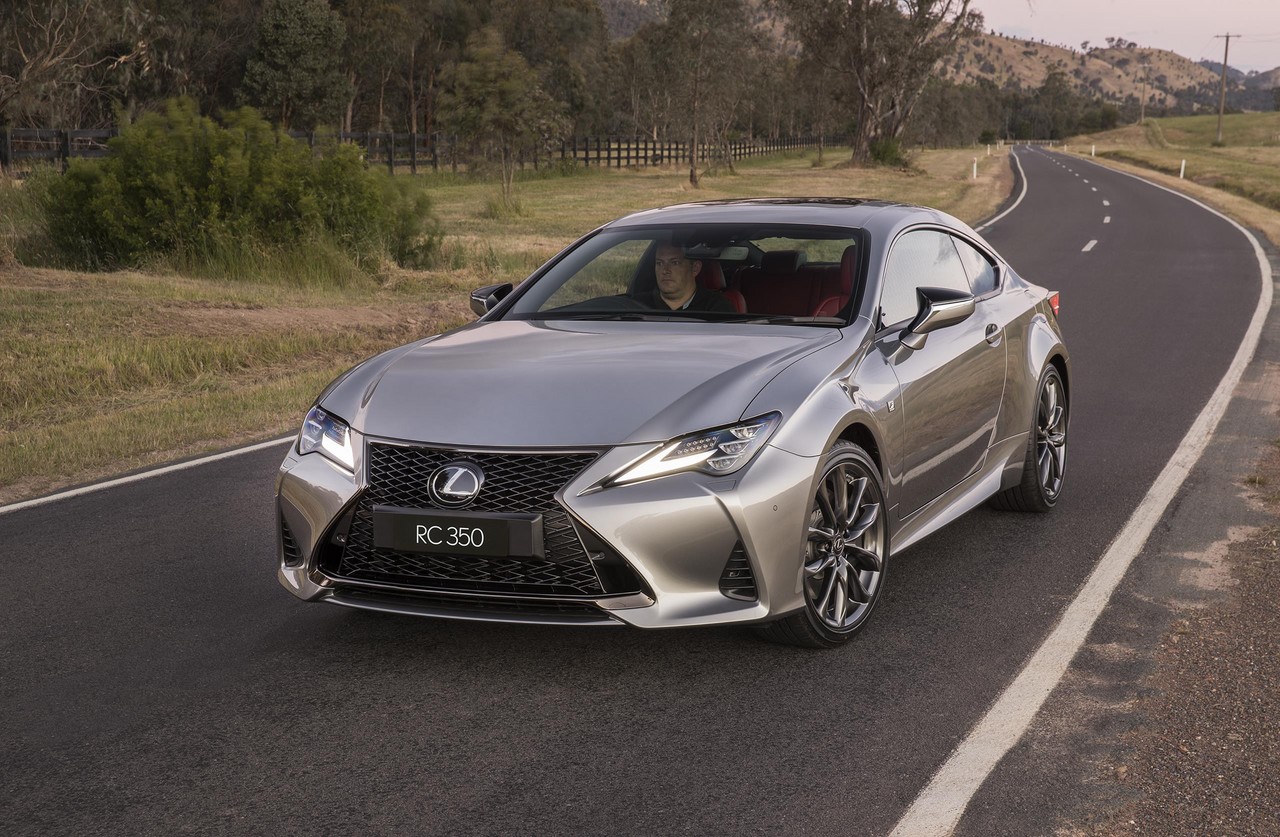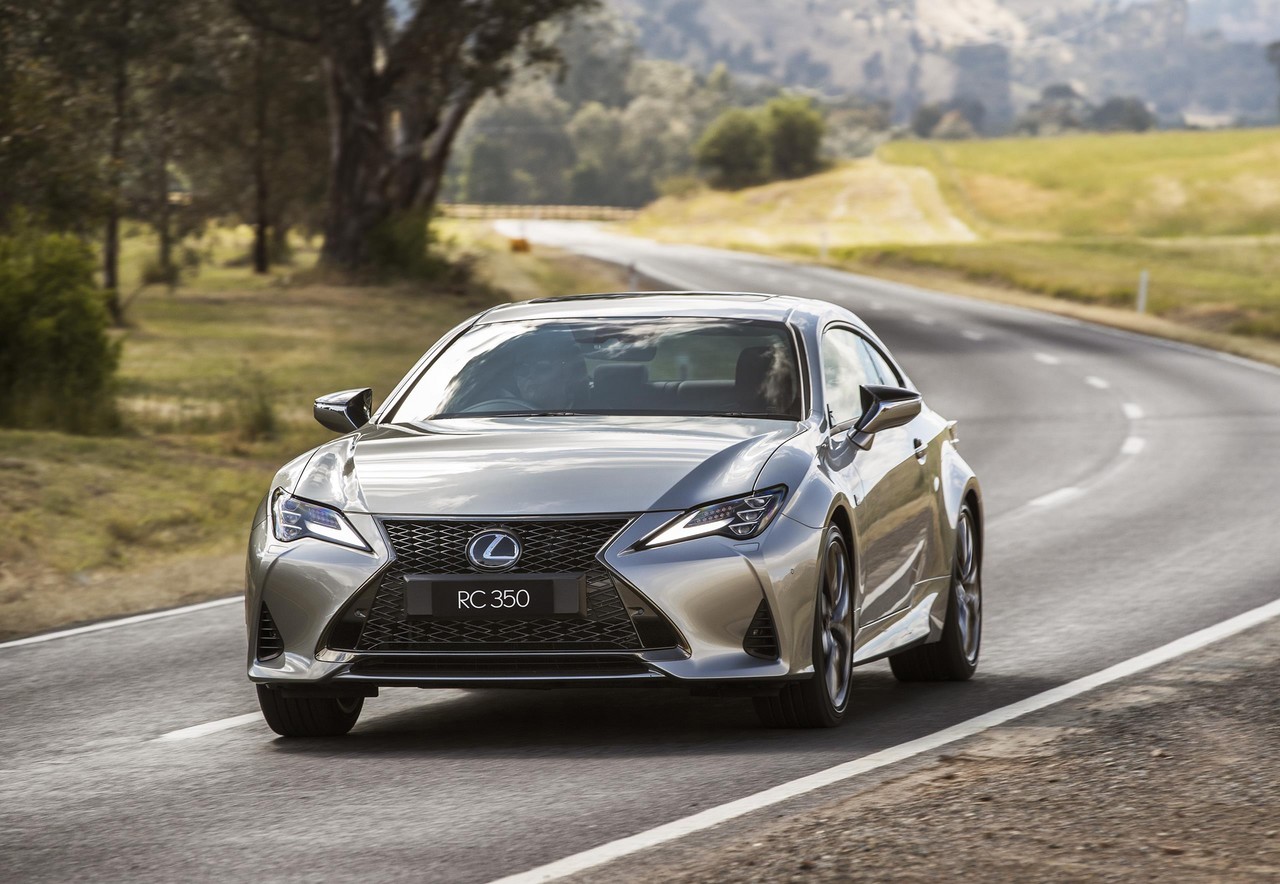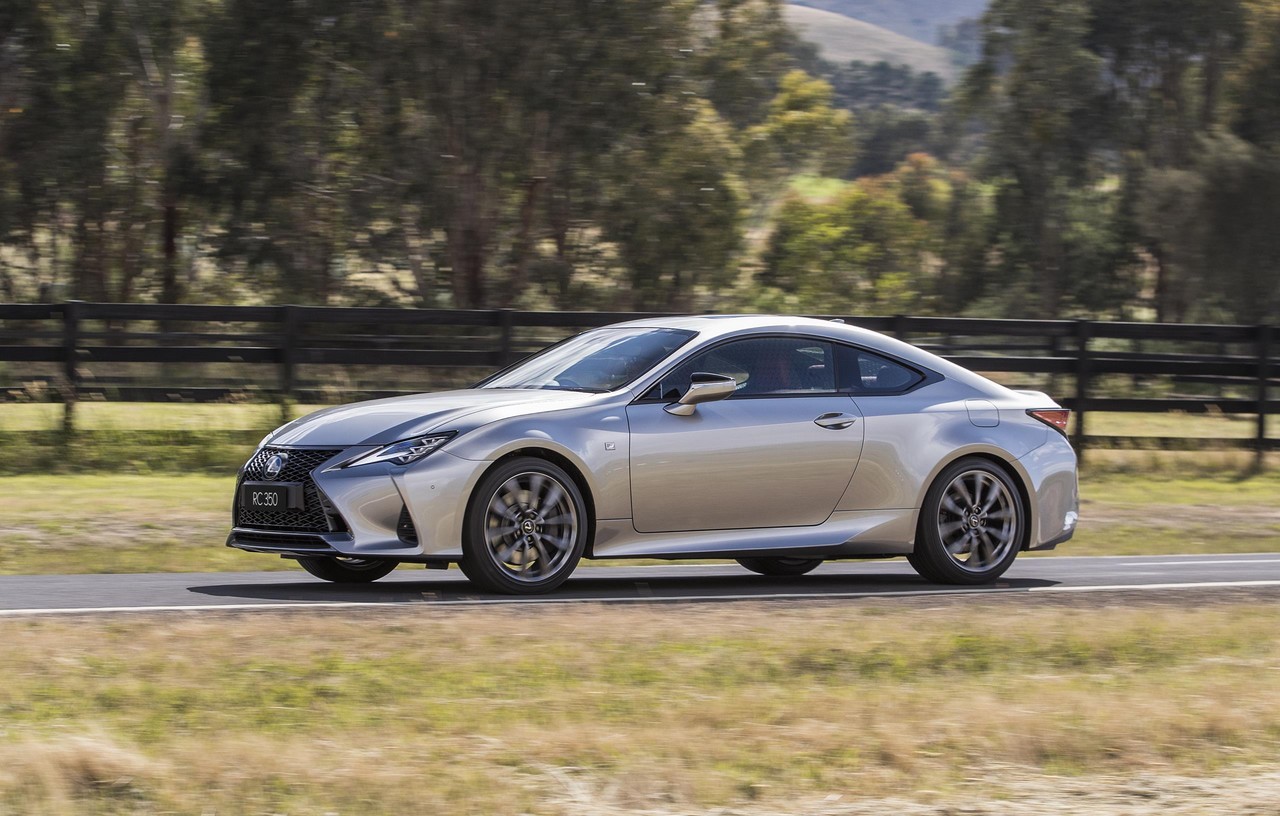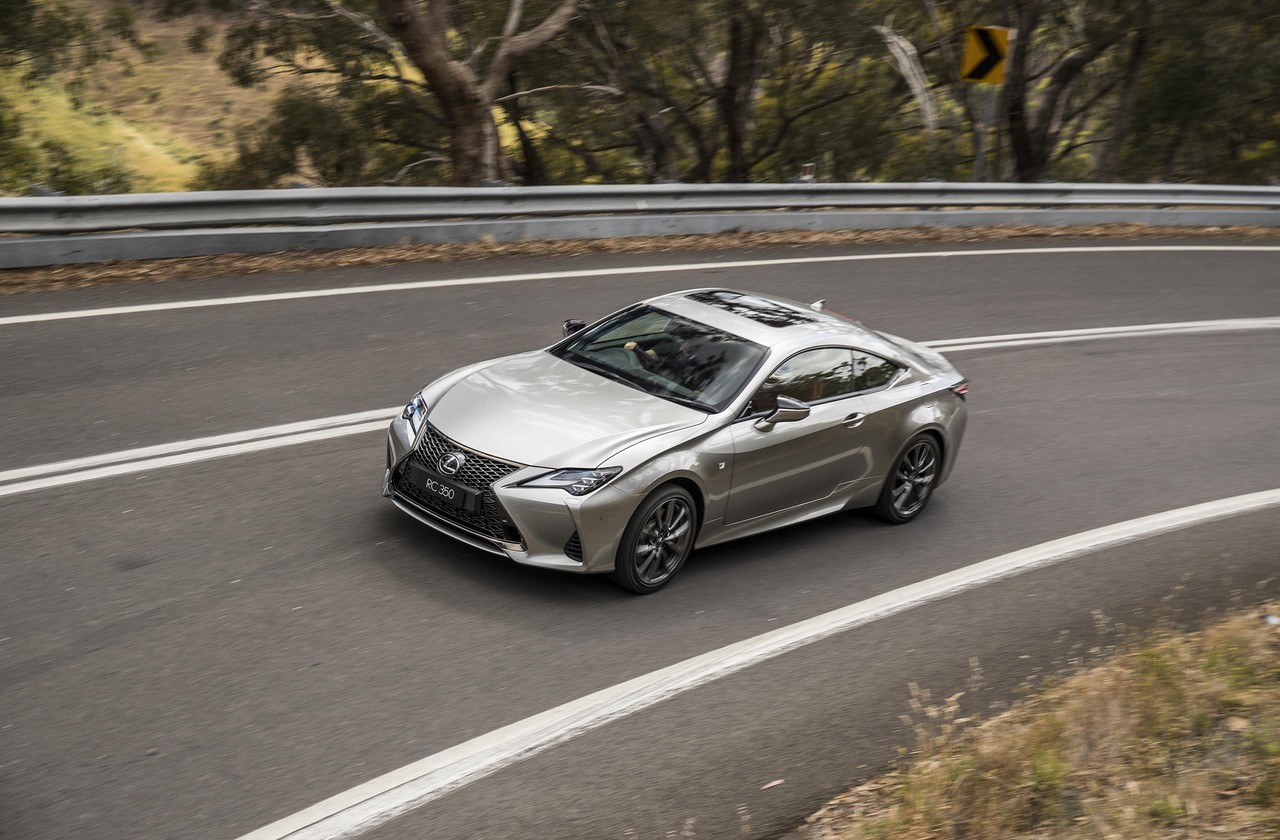
- For RC 200t, sophisticated 2.0-litre 8AR-FTS turbo engine is responsive and economical
- For RC 350, free-revving 3.5-litre 2GR-FSE engine
- Impressive ride/handling balance
- Heavy for a sports coupe
- Steering is unresponsive around centre
- Limited headroom
- Cramped rear seats
Review: Lexus XC10.I RC (2014-18)
Overview
Released in Australia in November 2014, the Lexus XC10 RC was a rear-wheel drive, four-seat coupe. Manufactured in Tahara, Japan, the Lexus RC range initially consisted on the RC 350 which was powered by a 3.5-litre V6 petrol engine. In December 2015, however, the RC 200t was released – it was powered by a 2.0-litre turbocharged four-cylinder petrol engine.
In March 2018, the Lexus XC10 RC ranged was updated:
- The RC 200t was renamed RC 300; and,
- The RC 350 was powered by the 2GR-FKS engine .
RC 200t and RC 300: 8AR-FTS engine
For the Lexus RC 200t and RC 300, the 2.0-litre 8AR-FTS turbocharged petrol engine has an aluminium block and aluminium cylinder head, direct and port injection (Toyota’s ‘D-4S’), a twin-scroll turbocharger (which provides maximum boost pressure of 17 psi or 1.17 bar), double overhead camshafts and four valves per cylinder.
While the exhaust valves had standard variable valve timing (Variable Valve Timing with Intelligence, or ‘VVT-i’), the intake valves had a mid-position camshaft lock mechanism which retarded the continuously variable valve timing, known as Variable Valve Timing-intelligent Wide (VVT-iW). The ability to retard intake valve timing enabled the engine to use an Atkinson cycle for low-rev operations to minimise fuel consumption and an Otto cycle at higher engine speeds for greater power.
The 8AR-FTS engine also had a ‘stop-start’ system which enabled it to shut down when the vehicle is stationary in traffic.
RC 350: 2GR-FSE and 2GR-FSK engine
For the Lexus RC 350, the 3.5-litre 2GR-FSE engine had an alloy cylinder block and head, direct injection and conventional port injection, double overhead camshafts (per cylinder bank), four valves per cylinder, variable intake and exhaust valve timing (‘dual VVT-i’) and a compression ratio of 11.8:1. Furthermore, the RC 350 had an eight-speed AA81 automatic transmission.
From March 2018, the Lexus RC 350 was powered by the 3.5-litre 2GR-FKS engine (shared with the Toyota XV70 Camry ). Compared to the 2GR-FSE, the 2GR-FKS had ‘Variable Valve Timing – Intelligent Wide’ (VVT-iW) for the intake valves – this used a mid-position camshaft lock mechanism to retard intake valve timing. VVT-iW enabled the 2GR-FKS engine to start in the Otto cycle, switch to an Atkinson cycle for low-rev operations (i.e. shortened compression stroke by delaying the closure of the intake valves during the compression stroke and a longer expansion stroke by delaying the closure of the intake valves until the end of the expansion stroke) and revert to an Otto cycle at higher engine speeds for greater power. Other changes for the 2GR-FKS engine included integration of the exhaust manifold into the cylinder head and cooled exhaust gas recirculation.
| Years | Engine | Trans. | Peak power | Peak torque | |
|---|---|---|---|---|---|
| RC 200t | 2014-18 | 2.0-litre 8AR-FTS turbo petrol I4 | 8sp auto | 180 kW at 4800-5600 rpm | 350 Nm at 1650-4000 rpm |
| RC 300 | 2018 | ||||
| RC 350 | 2014-18 | 3.5-litre 2GR-FSE petrol V6 | 8sp auto | 233 kW at 6400 rpm | 378 Nm at 4800 rpm |
| 2018 | 3.5-litre 2GR-FKS petrol V6 | 8sp auto | 232 kW at 6600 rpm | 380 Nm at 4800-4900 rpm |
Body and dimensions
According to Lexus, the RC was not based on any particular model but rather combined the front-end of the Lexus L10 GS , the rear of the Lexus XE30 IS and drew upon the body of the Lexus XE20 IS Convertible with its large rocker panels. For the first time in a Lexus, the RC used high rigidity glass adhesive that enables window glass to be treated as a structural member of the chassis.
Compared to the XE30 IS sedan, the Lexus RC was 30 mm longer (at 4695 mm), 30 mm wider (1840 mm), 35 mm lower (1395 mm) and had a 70 mm shorter wheelbase (2730 mm).
Suspension
The Lexus RC had double wishbone front suspension and independent, multi-link rear suspension. The Sports Luxury variants added Adaptive Variable Suspension (AVS) which consisted of electronically-controlled dampers that could adjust according to road conditions and driver preferences as chosen via the Drive Mode Select system. From December 2015, the F Sport variants were also fitted with Adaptive Variable Suspension (AVS).
The Lexus RC 200t/300 and, from December 2015, the Lexus RC 350 F Sport, were fitted with a ‘performance damper’ between the left and right front #2 braces/members to reduce vibration, increase stability and enhance steering response. From November 2016, the RC 350 Luxury and RC 350 Sports Luxury were also fitted with the front performance body damper.
Steering
The Lexus RC had electric, power-assisted steering (EPS) which could vary the level of power assistance according to the mode selected from the Drive Mode Select system. The EPS was integrated with the electronic stability control system so that, in the event that traction was lost, a limited amount of force-feedback could be applied to the steering wheel to ‘encourage’ the driver to apply the appropriate steering input.
The RC F Sport was further fitted with the Lexus Dynamic Handling (LDH) system which incorporated:
- Variable Gear Ratio Steering (VGRS) which varied the steering ratio according to vehicle speed and steering operation ; and,
- Dynamic Rear Steering (DRS) which could turn the rear wheels to complement the driving situation. At speeds of up to 80 km/h, DRS would turn the rear wheels in the opposite direction to the front wheels for tighter turns and increased cornering performance. At speeds above 80 km/h, the rear wheels would turn in the same direction as the front wheels for greater high-speed stability.
Safety equipment
Standard safety equipment for the Lexus XC10 RC included dual front airbags, dual front knee airbags, front side airbags, full-length curtain airbags, ABS, electronic brake force distribution, brake assist, electronic stability control, traction control and front seatbelts with pretensioners and load limiters. The Lexus RC also had a pop-up bonnet that could rise in the event of a pedestrian collision to provide a cushioning effect as the pedestrian impacted the bonnet.
The Lexus RC 350 F Sport was further equipped with:
- A Blind Spot Monitor (BSM): once the vehicle exceeded 40 km/h, sensors in the rear bumper could detect vehicles in the adjacent lanes. If the driver indicated to change lanes and a vehicle was detected, a warning tone would sound. The BSM could detect vehicles larger than an average 125 cc motorcycle and where the relative speed difference was up to 28 km/h;
- Rear cross-traffic alert: when reversing at speeds below 8 km/h, sensors in the rear bumper could detect approaching traffic travelling at speeds from 8 km/h to 28 km/h which may cross the vehicle’s path. If crossing traffic was detected, a warning tone would sound; and,
- Lane Change Alert: could detect vehicles that were approaching from behind. Although similar to the BSM, Lane Change Alert differed in the area it monitored and its response to the relative speed of other vehicles.
Beyond this, the Lexus RC Sports Luxury added:
- Lexus’ Pre-Collision Safety (PCS) system: used a millimeter-wavelength radar sensor in the grille to detect vehicles or other obstacles. When a collision risk was first anticipated, a buzzer would sound and a dashboard light would illuminate to warn the driver. In its second stage, Pre-Collision Brake Assist would be activated (at initial speeds above 30 km/h) to increase braking assistance if the driver applied the brakes. If a collision was unavoidable and vehicle speed was above 15 km/h, ‘Pre-Collision Brake’ (i.e. autonomous braking) would be activated to reduce vehicle speed. From March 2018, PCS could also detect pedestrians;
- Lane Departure Warning (LDW): used a camera sensor mounted near the rear view mirror to detect if the vehicle deviated from its lane position. If so, a warning tone would sound; and,
- Active Cruise Control (ACC): used the same radar sensor as PCS to monitor the distance to the vehicle ahead and then maintain a specified distance by controlling acceleration and braking. Active Cruise Control could operate at speeds between 40 km/h and 200 km/h.
From December 2015, however, the Pre-Collision Safety (PCS) system and Active Cruise Control were fitted as standard across the Lexus RC range.
In March 2018, LDW was replaced by LDW+ which provided steering wheel vibrations to alert the driver and steering assistance to guide the vehicle back into its lane.
Brakes
The Lexus RC Luxury and Sports Luxury variants had 334 mm by 30 mm ventilated front brake discs with four-piston calipers and 310 mm by 18 mm ventilated rear discs with single piston calipers. The RC F Sport, however, had 357 mm by 30 mm two-piece front discs, unique high friction brake pads and servo booster tuning for increased braking power.
Features: RC Luxury, F Sport and Sports Luxury
Standard features for the Lexus RC Luxury included five-spoke machine finished 18-inch alloy wheels with 235/45 R18 tyres, a 256 watt Pioneer sound system with ten speakers and digital radio (DAB+), Bluetooth mobile phone connectivity and audio streaming, a seven-inch media display with the ‘Lexus Remote Touch’ track pad, satellite navigation, Lexus’ ‘Enform’ applications, leather-accented seat trim, power adjustable front seats with heating and ventilation, LED headlights and fog lights, front and rear parking sensors, a rear view camera, a leather-wrapped steering wheel with gearshift paddles, 60:40 split and folding rear seats, remote central locking with proximity key (‘smart entry’), power windows and mirrors, a power adjustable steering column (for height and reach), push-button start, electrochromatic mirrors (internal and external), ambient lighting, a 4.2-inch TFT instrument panel, trip computer and an immobiliser. Furthermore, the driver could select from Eco, Normal and Sport settings from the Drive Mode Select.
The RC F Sport was further equipped with 19-inch twin ten-spoke F Sport alloy wheels with Bridgestone Potenza RE05A 235/40 R19 92Y front tyres and 265/35 R19 rear tyres, a Mark Levinson sound system with seventeen (17) speakers, power adjustable front seats with memory settings, high grade LED headlights, an F Sport steering wheel and an eight-inch TFT LCD instrument panel. For the Drive Mode Select system, the Sport setting was replaced by Sport S and Sport S+ settings.
Relative to the Luxury variant, the RC Sports Luxury added 19-inch ten-spoke alloy wheels, a Mark Levinson sound system with seventeen (17) speakers, semi-aniline leather upholstery, power adjustable front seats with memory settings, Shimamoku interior ornamentation, LED headlights with auto high beam, a smart key card and moonroof.
December 2015 update
From December 2015, the Lexus RC 200t F Sport and all RC 350 F Sport were fitted with a Torsen limited slip differential. Furthermore, Lexus’ Acceleration Sound Control (ASC) was added to the F Sport variants; ASC used a dedicated loudspeaker that was positioned behind the dashboard to provide additional engine noise into the cabin during acceleration and deceleration.
March 2018 updates
In March 2018, the Lexus RC was updated with improved safety equipment and upgraded features:
- The Pre-Collision Safety System could detect pedestrians (previously limited to vehicles);
- LDW was replaced by LDW+ which provided 1) steering wheel vibrations to alert the driver and 2) steering assistance to guide the vehicle back into its lane;
- Simplified switchgear for Active Cruise Control (ACC);
- A 10.3-inch touchscreen (replacing the previous 7-inch display);
- An upgraded multi-media system; and,
- A larger Lexus Remote Touch pad.
Brochure
Related links
- Lexus Australia: Lexus RC 350 Press Kit
- Lexus Australia: Lexus RC 200t and updates
- Lexus Australia: Dynamic, Safety and Feature Upgrades for Lexus RC F
Review: Lexus XC10.II RC (2018-21)
Overview
The Lexus XC10 Series II (XC10.II) RC was released in Australia in December 2018. Visually, the Lexus XC10.II RC could be identified by its new front bumper, LED headlamps, mesh pattern for the spindle grille, alloy wheels, door mirrors (shared with the Lexus Z100 LC ) and rear bumper. The Lexus RC F Sport was distinguished by its new ten-spoke 19-inch alloy wheels and ‘triple eye’ LED headlights.
Inside, the Lexus XC10.II RC had larger and higher knee pads surrounding the centre console, a new ‘brushed’ treatment for the heater control and audio panels and a new analogue clock (as per the Lexus LC) for the instrument panel. The Lexus XC10.II RC F Sport also gained Naguri aluminium trim inlays.
| Variant | Engine | Trans. | Peak power | Peak torque | |
|---|---|---|---|---|---|
| RC 300 | Luxury, F Sport |
2.0-litre 8AR-FTS turbo petrol I4 | 8sp auto | 180 kW at 4800-5600 rpm | 350 Nm at 1650-4000 rpm |
| RC 350 | Luxury, F Sport |
3.5-litre 2GR-FKS petrol V6 | 8sp auto | 232 kW at 6600 rpm | 380 Nm at 4800-4900 rpm |
Suspension
The Lexus XC10.II RC was equipped with new shock absorbers and stiffer suspension bushings to provide ‘a flatter, more supple ride quality and even sharper handling characteristics’. As standard, the Lexus RC 350 Luxury was equipped with Adaptive Variable Suspension (AVS).
Safety equipment
For the Lexus XC10.II RC, standard safety equipment was extended to include Lexus’ Blind-Spot Monitor (BSM), Rear Cross-Traffic Alert (RCTA) and Lane-Change Alert (LCA) – these items were previously omitted from the RC 300 Luxury and RC 350 Luxury.
Features
For the Lexus XC10.II RC, standard features were extended to include rain-sensing wipers, cornering lamps and electrochromatic door mirrors with memory settings.
Related links
- Lexus Press: Refined Styling and Dynamics for new Lexus RC Coupe (December 2018)
- Lexus Australia: Lexus RC
- Wikipedia.org: Lexus RC
